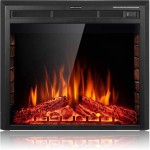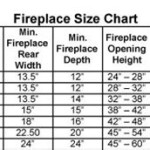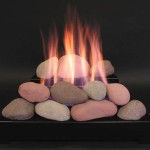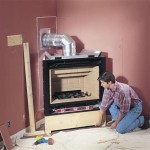Stacked Stone Fireplace With Wood Surround: A Harmonious Blend of Textures and Styles
The stacked stone fireplace with a wood surround represents a popular design choice for homeowners seeking a balance between rustic charm and contemporary elegance. This architectural feature brings the natural appeal of stone indoors, harmonizing it with the warmth and character of wood. The combination creates a focal point in a living space, providing both visual interest and practical functionality through the fireplace. This article will explore the various aspects of a stacked stone fireplace with a wood surround, including design considerations, material choices, installation processes, and maintenance requirements.
Design Considerations for Stacked Stone Fireplaces with Wood Surrounds
The design phase is critical to ensuring the successful integration of a stacked stone fireplace with a wood surround into a home. Several factors influence the overall aesthetic and functionality of the finished product. Room dimensions, existing architectural style, and personal preferences all play a role in determining the optimal design. The scope of the project may also affect the approach. Some projects may opt to retrofit an existing fireplace with a new surround, while others may involve building a new fireplace structure from the ground up.
Scale and proportion are essential considerations. A fireplace that is too large can overwhelm a small room, while one that is too small may be lost in a larger space. The height and width of the stacked stone portion, as well as the dimensions of the wood surround, must be carefully chosen to complement the room's overall proportions. Mockups, whether physical or digital, can be useful in visualizing the final result and making necessary adjustments before construction begins.
The architectural style of the home should also inform the design. A modern home may benefit from a sleek, minimalist stacked stone design with a clean-lined wood surround, while a more traditional home may call for a more rustic, textured stone and a more ornate wood surround. The goal is to create a cohesive look that integrates seamlessly with the existing décor and enhances the overall ambiance of the space.
Personal preferences regarding the style and mood of the room are paramount. Some homeowners may prefer a more subdued, natural look, while others may opt for a bolder, more dramatic design. The choice of stone type, wood species, and finish can all contribute to the desired effect. Consideration should also be given to the placement of the fireplace within the room. Optimal placement maximizes both visual impact and heating efficiency.
Material Choices: Stone and Wood
The selection of materials is a crucial step in creating a stacked stone fireplace with a wood surround. Both the type of stone used for the stacked stone portion and the type of wood used for the surround will significantly impact the overall look and feel of the fireplace. Each material offers different aesthetic qualities, durability characteristics, and cost considerations.
For the stacked stone, a variety of options are available, including natural stone and manufactured stone veneer. Natural stone options include slate, quartzite, limestone, and fieldstone, each offering unique textures, colors, and patterns. Natural stone tends to be more expensive and heavier than manufactured stone veneer, requiring more robust structural support. Manufactured stone veneer, on the other hand, is a lightweight, cost-effective alternative that mimics the appearance of natural stone. It is easier to install and comes in a wide range of styles and colors.
The choice of stone finish also affects the overall aesthetic. A rough, textured finish provides a more rustic, natural look, while a smoother, more polished finish offers a more contemporary feel. The color of the stone should complement the existing color palette of the room and the chosen wood for the surround.
When selecting wood for the surround, a variety of hardwoods and softwoods are available. Hardwoods, such as oak, maple, cherry, and walnut, are known for their durability and rich grain patterns. They are more resistant to scratches and dents, making them a good choice for high-traffic areas. Softwoods, such as pine, cedar, and fir, are less expensive and easier to work with. They are suitable for less demanding applications and can be stained or painted to achieve a variety of looks.
The finish of the wood surround is also an important consideration. A clear finish allows the natural beauty of the wood to shine through, while a stain can enhance the color and grain pattern. A painted finish can provide a more modern, contemporary look. The choice of finish should complement the style of the room and the chosen stone for the stacked stone portion.
Installation Processes and Considerations
The installation of a stacked stone fireplace with a wood surround is a complex process that requires careful planning and execution. Whether renovating an existing fireplace or building a new one, proper preparation, accurate measurements, and adherence to building codes are essential.
The foundation must be structurally sound and capable of supporting the weight of the stone. For new construction, this may involve pouring a concrete slab or building a reinforced platform. For existing fireplaces, the existing structure must be inspected to ensure it can bear the added weight of the stacked stone. Strengthening the existing structure may be necessary.
Proper ventilation is crucial for safe and efficient fireplace operation. An adequate flue and chimney system is necessary to vent smoke and gases safely out of the home. Local building codes dictate specific requirements for flue size, chimney height, and other ventilation-related factors. It is essential to consult with a qualified professional to ensure compliance with all applicable codes.
Installing the stacked stone involves applying the stone to the prepared surface using mortar. Proper mortar selection and application techniques are essential to ensure a secure and long-lasting bond. The stones should be carefully arranged to create a visually appealing pattern. This process often requires specialized tools and skills, and it is recommended to hire a professional mason for this part of the project.
The wood surround is typically constructed from pre-fabricated wood panels or custom-built from lumber. Accurate measurements and precise cuts are essential to ensure a proper fit around the fireplace opening. The surround must be securely attached to the fireplace structure using screws or nails. The joints should be carefully sealed to prevent air leaks and maintain a clean, finished look. The wood surround must also maintain a safe distance from the firebox opening as recommended by the manufacturer and building codes.
After installation, the fireplace should be thoroughly inspected to ensure it is functioning safely and efficiently. A professional inspection by a qualified fireplace technician is recommended to verify proper venting, gas connections, and overall system performance.
Proper finishing is crucial for a polished and professional look. This may include caulking gaps, sanding surfaces, and applying paint or stain to the wood surround. The finished product should be aesthetically pleasing and seamlessly integrated with the surrounding décor. Safety regulations should always be considered when undertaking any alteration to ensure compliance.
Choosing the correct type of stone is important. Lighter stones may be a better option for smaller rooms, whilst darker stones may be suitable for larger rooms. Consider the texture of the stone, and whether you prefer a rough or smooth finish. The color of the stone should coordinate with the rest of your home's interior. Remember the stone will be a central focal point.
The wood should be chosen for its ability to withstand heat. As well as practical considerations, think about the grain pattern and color of your wood choice. The wood frame should seamlessly blend and complement the stone of the fireplace. The style of trim chosen around the wood surround can enhance the overall look.
Maintaining a stacked stone fireplace with a wood surround involves regular cleaning and inspections to ensure its longevity and performance. Dusting or vacuuming the stone surface can help prevent the buildup of dirt and debris. Periodic cleaning with a mild detergent and water may be necessary to remove stubborn stains.
The wood surround should be cleaned regularly with a damp cloth to remove dust and grime. Avoid using harsh chemicals or abrasive cleaners, as they can damage the finish. Periodic re-staining or painting may be necessary to maintain the wood's appearance and protect it from moisture and wear.
Annual inspections by a qualified fireplace technician are essential to ensure the safe and efficient operation of the fireplace. The technician should inspect the flue, chimney, gas connections, and other components to identify any potential problems. Addressing minor issues promptly can prevent more significant and costly repairs in the future.
By carefully considering design elements, material choices, installation processes, and maintenance requirements, homeowners can successfully incorporate a stacked stone fireplace with a wood surround into their homes, creating a beautiful and functional focal point that enhances the ambiance and value of their living space.

Natural Stacked Stone Veneer Fireplace Ideas

Stacked Stone Fireplace 10 Luxurious Design Ideas Stoneyard

12 Stacked Stone Fireplace Ideas For Optimal Coziness

Fireplace Google Search Stacked Stone Fireplaces Surround Surrounds

12 Stacked Stone Fireplace Ideas For Optimal Coziness

Diy Stacked Stone Fireplaces On A Budget Msi Blog

Stacked Stone Fireplace With Wood Mantel Traditional Houzz

Cozy Stone Fireplace In Living Room

17 Modern Stacked Stone Fireplace Ideas For Your Home

Stacked Stone Fireplace Surround With Wood Mantle Andrea S Innovative Interiors Blog Warm Up By The Fire Home Design
Related Posts








